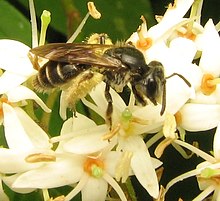33:
105:, though there are thousands of species in hundreds of genera, in essentially all known bee families; in certain areas of the world, such as deserts, oligoleges may represent half or more of all the resident bee species. Attempts have been made to determine whether a narrow host preference is due to an inability of the bee
120:) are visited by oligolectic bees, and these may fall into the former category. The evidence from large-scale phylogenetic analyses of bee evolution suggests that, for most groups of bees, oligolecty is the ancestral condition and polylectic lineages arose from among those ancestral specialists.
109:
to digest and develop on a variety of pollen types, or a limitation of the adult bee's learning and perception (i.e., they simply do not recognize other flowers as potential food sources), and most of the available evidence suggests the latter. However, a few plants whose pollen contains toxic
209:"Foraging and nesting biology of the bee Anthemurgus passiflorae (Hymenoptera, Apoidea), descriptions of its immature stages, and observations on its floral host (Passifloraceae). American Museum novitates ; no. 3138"
123:
There are some cases where oligoleges collect their host plant's pollen as larval food but, for various reasons, rarely or never actually pollinate the flowers. A well-studied example is the relationship between the
72:
of flowering plants. The preference may occasionally extend broadly to multiple genera within a single plant family, or be as narrow as a single plant species. When the choice is very narrow, the term
76:
is sometimes used, originally meaning a single plant species but recently broadened to include examples where the host plants are related members of a single genus. The opposite term is
181:
Cane, J.H. (2020) A brief review of monolecty in bees and benefits of a broadened definition. Apidologie 2020 DOI: 10.1007/s13592-020-00785-y
82:
and refers to species that collect pollen from a wide range of species. The most familiar example of a polylectic species is the domestic
162:
220:
236:
274:
37:
158:
32:
269:
212:
125:
249:
112:
263:
208:
133:
117:
57:
102:
98:
78:
83:
27:
Pollinators that exhibit a narrow, specialized preference for pollen sources
17:
216:
65:
141:
106:
69:
31:
61:
97:, and this behavior is especially common in the bee families
197:, 2nd Edition, Johns Hopkins University Press; pp. 19–21.
64:that exhibit a narrow, specialized preference for
8:
153:Proctor, M., Yeo, P. & Lack, A. (1996).
189:
187:
89:Oligolectic pollinators are often called
68:sources, typically to a single family or
207:Neff, John L.; Rozen, Jerome G. (1995).
174:
245:
234:
7:
223:from the original on 24 January 2021
155:The Natural History of Pollination
25:
157:. Timber Press, Portland, OR.
1:
291:
116:and related genera in the
48:, oligolectic on dogwoods.
138:Anthemurgus passiflorae
244:Cite journal requires
193:Michener, C.D. (2007)
95:specialist pollinators
49:
195:The Bees of the World
35:
126:yellow passionflower
60:ecology to refer to
110:substances (e.g.,
50:
134:passionflower bee
16:(Redirected from
282:
254:
253:
247:
242:
240:
232:
230:
228:
204:
198:
191:
182:
179:
130:Passiflora lutea
21:
290:
289:
285:
284:
283:
281:
280:
279:
260:
259:
258:
257:
243:
233:
226:
224:
206:
205:
201:
192:
185:
180:
176:
171:
150:
148:Further reading
38:dogwood andrena
28:
23:
22:
15:
12:
11:
5:
288:
286:
278:
277:
272:
262:
261:
256:
255:
246:|journal=
199:
183:
173:
172:
170:
167:
166:
165:
149:
146:
113:Toxicoscordion
26:
24:
14:
13:
10:
9:
6:
4:
3:
2:
287:
276:
273:
271:
268:
267:
265:
251:
238:
222:
218:
214:
210:
203:
200:
196:
190:
188:
184:
178:
175:
168:
164:
163:0-88192-352-4
160:
156:
152:
151:
147:
145:
143:
139:
135:
131:
127:
121:
119:
115:
114:
108:
104:
100:
96:
92:
87:
85:
81:
80:
75:
71:
67:
63:
59:
55:
47:
43:
39:
34:
30:
19:
237:cite journal
225:. Retrieved
202:
194:
177:
154:
137:
129:
122:
111:
94:
90:
88:
77:
73:
53:
51:
45:
41:
29:
275:Pollination
227:28 November
118:Melanthieae
58:pollination
56:is used in
264:Categories
169:References
132:) and the
103:Halictidae
99:Andrenidae
93:or simply
91:oligoleges
79:polylectic
54:oligolecty
46:Gonandrena
18:Polylectic
217:2246/3659
84:honey bee
74:monolecty
52:The term
44:Subgenus
221:Archived
270:Ecology
42:Andrena
161:
107:larvae
66:pollen
142:Texas
140:) in
70:genus
250:help
229:2020
159:ISBN
101:and
62:bees
36:The
213:hdl
266::
241::
239:}}
235:{{
219:.
211:.
186:^
144:.
86:.
40:,
252:)
248:(
231:.
215::
136:(
128:(
20:)
Text is available under the Creative Commons Attribution-ShareAlike License. Additional terms may apply.
